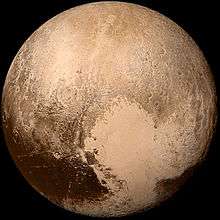2010 KZ39
| Discovery [1][2] | |
|---|---|
| Discovered by |
A. Udalski S. S. Sheppard M. Szymanski C. Trujillo (all unaccredited) |
| Discovery site |
Las Campañas Obs. (first observed) |
| Discovery date |
21 May 2010 (first observed) |
| Designations | |
| MPC designation | 2010 KZ39 |
| TNO[3] · Detached (SDO-EXT)[4] | |
| Orbital characteristics [3][4] | |
| Epoch 13 January 2016 (JD 2457400.5) | |
| Uncertainty parameter 5 | |
| Observation arc | 669 days (1.83 yr) |
| Aphelion | 47.718 AU (7.1385 Tm) |
| Perihelion | 42.830 AU (6.4073 Tm) |
| 45.274 AU (6.7729 Tm) | |
| Eccentricity | 0.053980 |
| 304.63 yr (111267 d) | |
| 252.10° | |
| 0° 0m 11.648s /day | |
| Inclination | 26.057° |
| 53.142° | |
| 316.76° | |
| Physical characteristics | |
| Dimensions |
600 km (est. at 0.10)[5] 420–940 km[6] |
| 20.7[7] | |
| 4.0[3] | |
|
| |
2010 KZ39 is a trans-Neptunian object orbiting the Sun as a Detached object in the outer reaches of the Solar System. It was first observed on 21 May 2010, by astronomers Andrzej Udalski, Scott S. Sheppard, M. Szymanski and Chad Trujillo at the Las Campañas Observatory in Chile.[1] Measuring several hundreds of kilometers in diameter, it is likely a dwarf planet.[5][6]

The minor planet orbits the Sun at a distance of 42.9–47.8 AU once every 305 years and 3 months (111,504 days), similar to Makemake, Chaos and other bodies that circle the Sun in 6:11 resonance to Neptune. Its orbit has an eccentricity of 0.05 and an inclination of 26° with respect to the ecliptic.
Using the best-fit values for its orbit, it is expected to come to perihelion in 2109.[3] It has been observed 28 times over 3 oppositions and has an uncertainty code of 5.[1] As of 2016, is 46.1 AU from the Sun.[7] The body's spectral type as well as its rotation period remain unknown.
Brown assumes an albedo of 0.10, resulting in an estimated diameter of 600 kilometers.[5] However, because the albedo is unknown and it has a preliminary absolute magnitude of 4.0,[3] its diameter could easily fall between 420 and 940 km[6] for an assumed albedo between 0.25 and 0.05, respectively.[8]
References
- 1 2 3 "(2010 KZ39)". Minor Planet Center. Retrieved 21 September 2016.
- ↑ "MPEC 2010-L38 : 2010 KZ39". IAU Minor Planet Center. 2010-06-08. Retrieved 2010-12-03.
- 1 2 3 4 5 "JPL Small-Body Database Browser: (2010 KZ39)" (last observation: 2012-03-20; arc: 1.83 years). Retrieved 31 March 2016.
- 1 2 Marc W. Buie. "Orbit Fit and Astrometric record for 10KZ39" (last observation: 2012-03-20 using 28 of 28 observations over 1.83 years). SwRI (Space Science Department). Retrieved 2011-08-18.
- 1 2 3 Michael E. Brown. "How many dwarf planets are there in the outer solar system? (updates daily)". California Institute of Technology. Retrieved 21 September 2016.
- 1 2 3 "Absolute Magnitude (H)". NASA/JPL. Retrieved 2011-07-19.
- 1 2 "AstDyS: 2010 KZ39 Ephemerides". AstDyS. Retrieved 2014-04-07.
- ↑ Dan Bruton. "Conversion of Absolute Magnitude to Diameter for Minor Planets". Department of Physics & Astronomy (Stephen F. Austin State University). Archived from the original on 23 July 2011. Retrieved 2011-08-18.
External links
- Large New Trans-Neptunian Object 2010 KZ39 Discovered (BAA Blog : 9 June 2010)
- OCKS: OGLE Carnegie Kuiper belt Survey (OCKS is a Southern sky survey searching for Kuiper Belt objects and dwarf planets)
- Orbital simulation from JPL (Java) / Horizons Ephemeris
- 2010 KZ39 at the JPL Small-Body Database

_(cropped).jpg)

